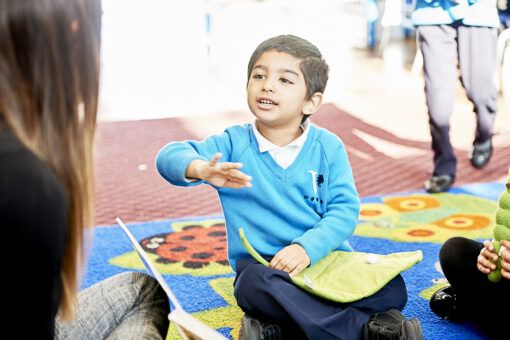
ABC @ Home Blog Series
By Lauren Thorpe, Head of Data, Systems and Improvement at Ark Schools
In our first blog in this series, we described how the ABC @ Home is an iteration of the Ark Base Curriculum – an approach to structuring the curriculum that our schools are already familiar with. It brings together the best work of our curriculum partners and schools to create an aligned curriculum entitlement for all of our students whilst they are accessing learning at home. The ABC @ Home is a live framework, it will improve over time – and we recognise that we are all novices in supporting our students to learn at home in this way.
The first blog set out the principles which informed the development of the ABC @ Home. We know that we cannot replicate school at home. Below, we set out the objectives we want to secure through our approach to home learning.
We wanted to ensure that;
- The disadvantage gap does not widen
- Gaps in knowledge do not slow down later learning
- Students do not feel alone or forgotten
- Parents and students feel reassured
- School staff, pupils and families can sustain the mode while schools remain closed
With clear objectives established, we were able to be specific about how the ABC @ Home would operate to achieve them. This has enabled us to evaluate the content and new resources to be added to the ABC @ Home, and also to guide schools’ implementation of the framework across the summer term.
Support pupils to remember and apply already acquired knowledge
We want pupils to revisit and build upon concepts and ideas that are already familiar to them. As a result, our home learning resources contain a high ratio of practice. This will reduce the load on ‘parents as teachers’ as well as lower the risk of pupils becoming disengaged with the learning. Of course, they should provide stretch and challenge, but within concepts and ideas which are already familiar.
New learning should focus on non-foundational/core knowledge
This is perhaps the most controversial element of our framework as teachers and leaders are rightly anxious that pupils do not fall behind. However, not all pupils will learn as effectively through an online and independent learning approach. Home learning is not equitable – and many children will find learning new things hard without support. It is also difficult to identify misconceptions that develop when learning new knowledge in this way. We have asked schools to think carefully whether it is appropriate to introduce new knowledge and concepts to pupils. A good example here might be in English – if your usual curriculum has Summer term as poetry in Year 7, do you really want your students’ first experience of poetry in a new genre to be encountered at home? Would it be possible to swap that unit with another one planned in year 8?

Activity should be purposeful, manageable and not lead to ‘busy work’
We will only create or signpost resources which are well thought through and we can be confident that they will deliver impact (towards our aims). It should not lead to ‘busy work’ for parents, pupils or teachers. As far as possible our approach lends itself to independent learning, as we know that most parents and carers do not have the capacity to support their child’s learning all day.
We must monitor engagement and continue to evaluate
In order to check that our approach is equitable and inclusive, it is important to ensure that schools build in a mechanism to monitor the engagement of pupils and that they act upon this information. We will need to iterate. Across each school the approach will differ, starting small and strengthening as confidence grows. We are likely to make mistakes but will learn as we go. Schools may ‘step-up’ or ‘step-down’ their home learning approach based on feedback from pupils and teachers.
We must ensure an equitable approach
From the outset, it has been clear that technology would need to support our home learning strategy. As the crisis began to unfold, the internet, twitter and platforms such as LinkedIn became flooded with free products and resources to support teachers and students. We have provided all of our schools with a clear steer that they should not introduce any new digital approach into their teaching and learning model. Yet. As I have written before, reactive use of technology doesn’t usually deliver the impact that you are hoping for.
We wanted to understand the equity of provision of technology in our students’ homes. A network wide technology survey was distributed via text messages to our families. With almost 10,000 responses so far, we are building a clear picture of the technology available. We have been surprised by a higher level of access to personal devices than we anticipated, but the gap between those that have and have not is still wide. We have always been aware of the issue of digital poverty, but it has never had the potential to have such a detrimental impact as now. Our framework has therefore been designed with three levels:
- There is a universal offer which all schools must ensure is in place for pupils. This determine the best way to distribute materials based on the access available – it might be posted home, delivered by a teacher, uploaded onto the school website, provided through an existing homework platform, or (most likely) a combination of the above!
- Only a small number of schools will choose to enable real-time learning using MS Teams. We acknowledge its benefits – it can lead to more impactful remote learning, support student engagement and motivation, and enable instant feedback and clarification to avoid misconceptions emerging. However, schools should not try to replicate their full timetable using this approach, and it should only be deployed where there is equity of access to technology. Unless all students have the devices available to enable this, schools should not rely upon this method of delivery.
- Most schools will successfully deliver a blended approach which uses the universal resources provided, alongside technology platforms that they are already familiar with, perhaps supplemented with some live learning based on the knowledge of cohorts and their access to technology.
In our next blog, we will talk through the thinking behind how we are organising the ABC @ home timetable